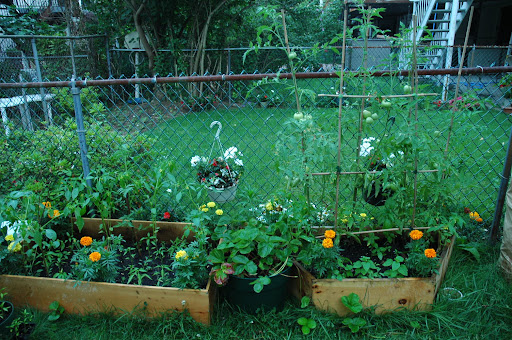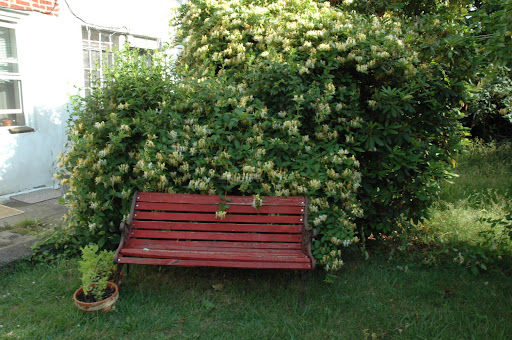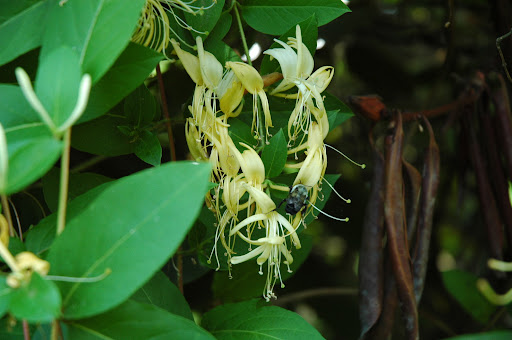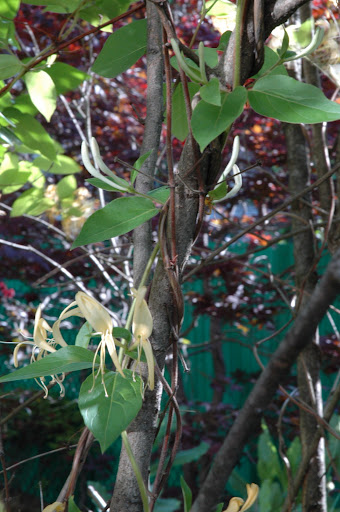
Sunday, September 30, 2007
Friday, August 31, 2007
Saturday, August 25, 2007
Thursday, August 23, 2007
excerpt from current reading: one
This is taken from The Revolution will not be Microwaved, in which I am currently engrossed.
In the 1990's Mayor Rudolph Guiliani implemented a wholesale transfer of hundreds of city-owned lots with gardens on them to the city's Department of Housing Preservation and Development (HPD), which arranged to put 112 of them up for auction at once in the spring of 1999. When asked why the city was auctioning the gardens, the mayor responded "This is a free-market economy; welcome to the era after communism." The idea that the city would encourage permanent community-based gardening on its unused land was regarded as absurd and contrary to the laws of the market. Privatization of all resources is the "free-market" creed. "We are trying to privatize as many city-owned properties as we can," confirmed an HPD official.
Bette Midler stepped in, in the eleventh hour, to purchase the gardens and preserve these green spaces, creating the now famous New York Restoration Project. The author of Revolution, Sandor Ellix Katz, asserts (and I agree) that private persons and industry should not be solely responsible for acquiring and maintaining spaces that are meant for the good of the public.
In the 1990's Mayor Rudolph Guiliani implemented a wholesale transfer of hundreds of city-owned lots with gardens on them to the city's Department of Housing Preservation and Development (HPD), which arranged to put 112 of them up for auction at once in the spring of 1999. When asked why the city was auctioning the gardens, the mayor responded "This is a free-market economy; welcome to the era after communism." The idea that the city would encourage permanent community-based gardening on its unused land was regarded as absurd and contrary to the laws of the market. Privatization of all resources is the "free-market" creed. "We are trying to privatize as many city-owned properties as we can," confirmed an HPD official.
Bette Midler stepped in, in the eleventh hour, to purchase the gardens and preserve these green spaces, creating the now famous New York Restoration Project. The author of Revolution, Sandor Ellix Katz, asserts (and I agree) that private persons and industry should not be solely responsible for acquiring and maintaining spaces that are meant for the good of the public.
Tuesday, August 21, 2007
can this be rectified?
I bought the majority of my organic seeds this year from the Seeds of Change catalog. There is no indication, on their website, in the catalog, on their food products, that they are in fact owned by M&M/Mars. Technically, its through their subsidiary Masterfoods USA. It is an understatement to say that I am currently beside myself, furious that I have unintentionally bought into a major corporation when I thought that I was creating something entirely out of the hands of industrialized America. Of course there are numerous other seed companies that are unaffiliated with the web of organic profiteering, and next year when I purchase seed I will be sure to research the company thoroughly and consult this useful guide. As a disclaimer, I am not sure if Masterfoods participates in disagreeable business practices and my condemnation warrants further research but I can' t shake this feeling of disappointment and a little shame for being so gullible.
Thursday, August 2, 2007
approaching harvest
Well, that's not entirely true. We have picked some red tomatoes, which are more mealy and bland than I had expected, but I suspect they are a sauce variety. The seeds came from a tomato that I was eating when taking a break from establishing packaged seeds. I cut into the fruit and noticed that some of the seeds had little green shoots so I cleaned them off and planted them and they quickly developed into great plants. since I'm still learning about the nuances of agricultural technology, I may be incorrect in saying that this means that the mother tomato was not a hybrid or genetically engineered, but in this case I'm going to assume it's so. Regardless of the slight graininess, they are sweet and taste like the fruit of labor.
Friday, July 27, 2007
companion planting
This photo is a bit outdated at this point (taken July 9), as my garden is now reaching twice the size as shown, but I wanted to talk a bit about the marigolds that you can see planted among the tomatoes and other greens.

I had read somewhere, (and honestly I don't know where) but I realize that it is probably common knowledge that marigolds provide terrific pest control around tomatoes. The first spring we lived in this apartment I tried to do some container gardening, and the herbs were overtaken by little gnat-like creatures that bored their way into the leaves of the herbs and stayed there. They were impossible to wash out, and the natural garlic spray I mixed was useless, so my thyme and oregano lived for decoration alone. A neighbor told me that she has had a terrible time keeping anything because of these bugs, so she just gave up planting.
Although my science is not yet on solid ground, my plants have been mostly pest free thus far. I did buy some garlic and peppermint spray from the Brooklyn Botanic garden shop, but have only had to spray a few times at the beginning of the summer. Could it be the marigolds? Could it be the mixed beds? Could it be fate? To really find out I would need to create a control... but I can't bear sacrificing seedlings in the name of progress. Maybe next year.
I had read somewhere, (and honestly I don't know where) but I realize that it is probably common knowledge that marigolds provide terrific pest control around tomatoes. The first spring we lived in this apartment I tried to do some container gardening, and the herbs were overtaken by little gnat-like creatures that bored their way into the leaves of the herbs and stayed there. They were impossible to wash out, and the natural garlic spray I mixed was useless, so my thyme and oregano lived for decoration alone. A neighbor told me that she has had a terrible time keeping anything because of these bugs, so she just gave up planting.
Although my science is not yet on solid ground, my plants have been mostly pest free thus far. I did buy some garlic and peppermint spray from the Brooklyn Botanic garden shop, but have only had to spray a few times at the beginning of the summer. Could it be the marigolds? Could it be the mixed beds? Could it be fate? To really find out I would need to create a control... but I can't bear sacrificing seedlings in the name of progress. Maybe next year.
the tomatillo
The husk tomato is a food staple in Mexican cooking. As the main ingredient in green salsa, it's utilized in dishes from enchiladas to chilaquiles. Pancho's mother purees a green salsa with avocado, making a thick, smooth sauce which is great on fried fish or eggs.
Having never grown this type of plant before, the cultivation was a total experiment. I was concerned that the soil in my garden bed would not be sandy enough for these southern-grown seedlings to root and prosper, but I combined them with jalepeno and poblano pepper plants, and put sage and basil in the gaps, hoping that the mix would create an environment that would allow the plants to nutritionally support each other. Well, I don't know if it's the combination planting, or the compost rich soil, but the tomatillo plants are doing fabulously. The grow tall, like tomatoes, but spread into bushes, attaching their branches to each other in a web of long green stalks and pretty yellow blossoms.
The pic shows the beginning formation of the outer husk that the tomatillo will eventually grow into. At this stage, I have about 35 hollow husks, hanging like chinese lanterns off the long stalks.
Tuesday, July 17, 2007
breaking the silence
Tuesday, June 19, 2007
extraction
Despite my somewhat limited research into the japanese honeysuckle, we decided that the plant had to go - especially since upon taking a closer look we discovered that its strong vines were strangling the life out of the trees it had wrapped itself around. The extraction took few hours, using wire snips to cut the vines away from the original tree. I read that the plant will not regrow if cut to within 4 inches of its root. I really had to question whether to remove the honeysuckle, since I was seeing more bees back in the yard and the leafy foliage offered extra privacy and honestly seemed to belong in the yard. But it was slowly destroying a hydrandea bush, a lilac tree and a rhododendrun that's the sie of a small tree. We bagged up the remains in the fall composting bags that the city distributes and hope that the garbage man will direct them to the composting center even if its not the right season. So, while I didn't take the buds down to Chinatown to sell for medicinal tea, the trees are doing a lot better now and the backyard has gained some space.


Friday, June 15, 2007
it smells sweet
I am working on a post on invasive species – specifically the Japanese Honeysuckle, which has completely taken over the periphery of our backyard, suffocating small trees and shrubs and rapidly spreading its vines until I fear it will completely dominate the entire courtyard. Thing is, I don’t want to start removing it until I know that there is no direct benefit to the environment, such as being very attractive to pollinators, which are becoming more rare almost daily. As I hope to research further, the plant has supposed medicinal and insecticidal uses, but has been quite a bother to the eastern
no direct benefit to the environment, such as being very attractive to pollinators, which are becoming more rare almost daily. As I hope to research further, the plant has supposed medicinal and insecticidal uses, but has been quite a bother to the eastern U.S.
 no direct benefit to the environment, such as being very attractive to pollinators, which are becoming more rare almost daily. As I hope to research further, the plant has supposed medicinal and insecticidal uses, but has been quite a bother to the eastern
no direct benefit to the environment, such as being very attractive to pollinators, which are becoming more rare almost daily. As I hope to research further, the plant has supposed medicinal and insecticidal uses, but has been quite a bother to the eastern Tuesday, June 5, 2007
kudzu
So my parents have a couple of parcels of land in South Carolina that are completely overgrown with kudzu, which, being from CT I had never before heard of. I have a lot more to learn about permaculture before finding a botanical solution that we can plant to rid the land of the invasive species, but take a look at this article from the Times re specially trained goats and their use in reducing kudzu:
http://www.nytimes.com/2007/06/05/us/05goats.html?ex=1338696000&en=7965e814b49e840b&ei=5124&partner=permalink&exprod=permalink
http://www.nytimes.com/2007/06/05/us/05goats.html?ex=1338696000&en=7965e814b49e840b&ei=5124&partner=permalink&exprod=permalink
Tuesday, May 29, 2007
gardening & g.w. - and i don't mean george w.
So, apparently this global warming this is happening. As a short intro to possible further posts on this topic, it appears that even those who tinker with gardening are going to have to make small to significant changes in how they do things. I'm still waiting for a good shady day to let my slightly hardened seedlings sit outside before transferring them into the ground. I'm scared that the sun is going to fry them before they have a chance... but Pancho and I may try to build a tent-like covering to protect the small plants from the direct sunlight when planted. If any of you have any other ideas or advice, I would love to hear!
The link is the National Wildlife Federation's Gardener's Guide to Global Warming.
http://www.nwf.org/gardenersguide/Gardeners_Guide.pdf
The link is the National Wildlife Federation's Gardener's Guide to Global Warming.
http://www.nwf.org/gardenersguide/Gardeners_Guide.pdf
Thursday, May 24, 2007
Garden box – easy to build, even for a girl
.DOC) Last Saturday I went to my local hardware store, Doody, intentionally avoiding HomeDepot because of the crowds and the usual desire to patronize a smaller establishment, to by a few boards to assemble this lovely garden box that you can see in the picture. I’m going to chart the 1-10 level of “what do you want that for” looks I get from male clerks when buying various things at hardware stores. This shopping trip I got about a 6.5 of doubt and 2.5 of shock after carrying a 10’ x 1’ x ½” board over to the tall aproned Russian boy in the far end of the wood department so he could make a few cuts for me. “You know you have to buy the whole thing” “Yeah – I need three cuts, one four ft piece and three two’s, OK?” “Alright… (he cuts the wood) But let me bring it over to the register for you.” “Thanks.”
Last Saturday I went to my local hardware store, Doody, intentionally avoiding HomeDepot because of the crowds and the usual desire to patronize a smaller establishment, to by a few boards to assemble this lovely garden box that you can see in the picture. I’m going to chart the 1-10 level of “what do you want that for” looks I get from male clerks when buying various things at hardware stores. This shopping trip I got about a 6.5 of doubt and 2.5 of shock after carrying a 10’ x 1’ x ½” board over to the tall aproned Russian boy in the far end of the wood department so he could make a few cuts for me. “You know you have to buy the whole thing” “Yeah – I need three cuts, one four ft piece and three two’s, OK?” “Alright… (he cuts the wood) But let me bring it over to the register for you.” “Thanks.”Pancho and I worked together the following day to saw the appx. 45 degree angle with a handsaw and then hold the pieces together for each other while drilling and screwing… teamwork is cool. Then I used some sheet gardening techniques: several sheets of very wet newspaper laid right on top of the grass, covering the entire ground inside the box, a layer of sticks and twigs from around the yard, then a mixture of garden soil, organic top soil and compost from the give back on top. I transplanted my tomato and small basil plants (grown from seed – planted first in March) and covered the rest of the soil with the leaves to protect the bed from weeds and to keep moisture in. So the plants have been in for almost a week now and seem to be doing well.
Wednesday, May 23, 2007
waste in our literature
And to complement my most recent entry - an opinion piece in the Guardian calling for a bard of waste... lets see who steps up...
the three r's
.DOC) This year the big apple launched a fabulous program titled NYC Waste Less, where NYC residents were able to shovel and keep as much free compost as they could haul at several compost “give backs.” The golden soil came from the millions of Christmas trees and bags of leaves and other assorted yard waste New Yorkers produce each season. For me, the most exciting part of the give back this year—and what could possibly be more exciting then free recycled waste, you may ask—was the opportunity to buy my own composting bin, at a hugely discounted price! See photo.
This year the big apple launched a fabulous program titled NYC Waste Less, where NYC residents were able to shovel and keep as much free compost as they could haul at several compost “give backs.” The golden soil came from the millions of Christmas trees and bags of leaves and other assorted yard waste New Yorkers produce each season. For me, the most exciting part of the give back this year—and what could possibly be more exciting then free recycled waste, you may ask—was the opportunity to buy my own composting bin, at a hugely discounted price! See photo.I think I may be one of the rare and few people who actually feel guilty tossing an apple core into the garbage bag. It could be my early childhood conditioning watching my grandmother store all her kitchen scraps in a huge brown margarine container on the counter, then give to my grandfather so he could add it to the compost pile, out behind the sprawling garden. So, now I have installed a functional remedy for my guilt. Composting is an easy process with great benefits. Although the next door neighbor was quick to watch us assemble the plastic box and make sure that the “lid fit on really tight because squirrels are a big problem around here.” It does. Here are a couple composting links.
http://en.wikipedia.org/wiki/Composting
http://www.gardenguides.com/how-to/tipstechniques/planning/compost.asp
Tuesday, May 22, 2007
fun with plants

Welcome to my shiny new blog! I intend to use this platform as a space for recording and reflecting on my adventures in horticulture; lessons, tips, anecdotes and troubles. And yes, humble reader, I do hope to make it as entertaining as possible. So, enjoy yourself, check back often and feel free to comment.
Subscribe to:
Posts (Atom)








